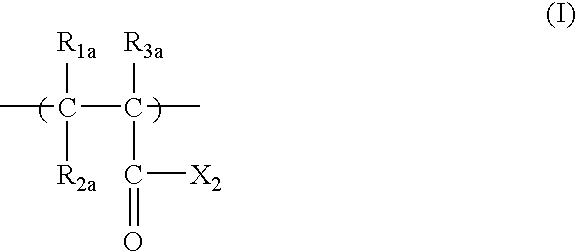Positive resist composition and pattern formation method using the same
- Summary
- Abstract
- Description
- Claims
- Application Information
AI Technical Summary
Benefits of technology
Problems solved by technology
Method used
Image
Examples
synthesis example 1
Synthesis of Intermediate (MA)
In 500 ml of tetrahydrofuran were dissolved 56.05 g (0.5 mol) of itaconic anhydride and 92.4 g (0.65 mol) of trifluoromethyltrimethylsilane and the resulting solution was cooled to −10° C. under nitrogen atmosphere with stirring. To the solution was dropwise added 25 ml (0.025 mol) of a 1 M tetrahydrofuran solution of tetrabutylammonium fluoride. After the completion of the dropwise addition, the temperature of the reaction solution was raised to room temperature, followed by further stilling for 3 hours. Then, a saturated aqueous solution of sodium hydrogen carbonate and ethyl acetate were added to the reaction solution to conduct separation operation. The organic layer was dehydrated with anhydrous sodium sulfate, and the solvent was distilled off. The product was purified by silica gel column chromatography to obtain 42.85 g (yield: 34%) of Intermediate (MA) shown below.
synthesis example 2
Synthesis of Intermediate (MB)
In 200 ml of tetrahydrofuran were dissolved 37.82 g (0.15 mol) of Intermediate (MA) and 50 ml of triethylamine and the resulting solution was cooled to 0° C. under nitrogen atmosphere with stirring. To the solution was dropwise added 38.28 g (0.38 mol) acetic anhydride over a period of 2 hours. After the dropwise addition, the reaction solution was heated to 90° C., followed by stirring for 4 hours. The reaction solution was neutralized with 1N aqueous hydrochloric acid solution, washed with ethyl acetate-water and extracted. The organic layer was dehydrated with anhydrous sodium sulfate, and the solvent was distilled off to obtain 37.95 g (yield: 86%) of Intermediate (MB) shown below.
synthesis example 3
Synthesis of Intermediate (MC)
In 200 ml of tetrahydrofuran were dissolved 32.36 g (0.11 mol) of Intermediate (MB), 24.46 g of tert-butyl alcohol and 10.75 g (0.088 mol) of 4-dimethylaminopyridine, followed by stilling. To the solution was dropwise added a chloroform (25 mol) solution containing 24.97 g (0.12 mol) of dicyclohexylcarbodiimide. After the dropwise addition, the reaction solution was further stirred for 3 hours, and 1N aqueous hydrochloric acid solution and ethyl acetate were added thereto to conduct separation operation. The organic layer was washed with a saturated aqueous solution of sodium hydrogen carbonate, dehydrated with anhydrous sodium sulfate, and the solvent was distilled off. The product was purified by silica gel column chromatography to obtain 29.28 g (yield: 76%) of Intermediate (MC) shown below.
PUM
 Login to View More
Login to View More Abstract
Description
Claims
Application Information
 Login to View More
Login to View More - R&D
- Intellectual Property
- Life Sciences
- Materials
- Tech Scout
- Unparalleled Data Quality
- Higher Quality Content
- 60% Fewer Hallucinations
Browse by: Latest US Patents, China's latest patents, Technical Efficacy Thesaurus, Application Domain, Technology Topic, Popular Technical Reports.
© 2025 PatSnap. All rights reserved.Legal|Privacy policy|Modern Slavery Act Transparency Statement|Sitemap|About US| Contact US: help@patsnap.com



